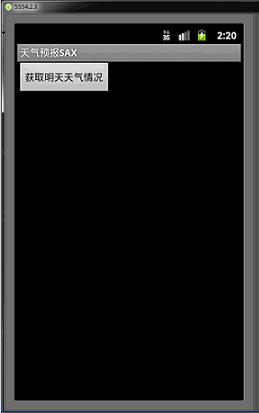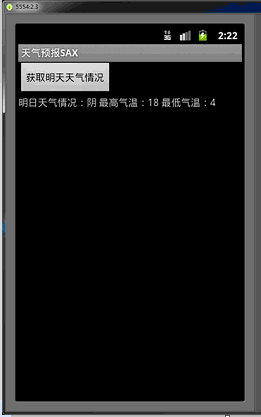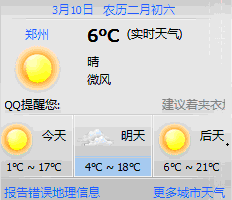Android系统中解析XML通常使用三种方法,分别是SAX、pull和DOM。这三种方法各有优缺点。本文将在一个简单的Google天气预报实例的基础上,来讲解如何使用SAX和pull方式解析XML文件。
一、Google天气预报API简介
我们上一讲的时候使用过Google Weather API,这里要说明的是Google Weather API 并不是官方提供的,是非公开的API,你可以拿来用,但是不能保证准确和及时。
首先我们可以根据经纬度来获取天气信息。
http://www.google.com/ig/api?hl=zh-cn&ie=utf-8&weather=,,,34720001,113650001
上面网址查询的结果如下所示:
- <?xml version="1.0"?>
- <XML_API_REPLY version="1">
- <WEATHER module_id="0" tab_id="0" mobile_row="0" mobile_zipped="1" row="0" section="0">
- <FORECAST_INFORMATION>
- <CITY data="" />
- <POSTAL_CODE data="" />
- <LATITUDE_E6 data="34720001" />
- <LONGITUDE_E6 data="113650001" />
- <FORECAST_DATE data="2011-03-08" />
- <CURRENT_DATE_TIME data="2011-03-08 14:00:00 +0000" />
- <UNIT_SYSTEM data="SI" />
- </FORECAST_INFORMATION>
- <CURRENT_CONDITIONS>
- <CONDITION data="晴" />
- <TEMP_F data="" />
- <TEMP_C data="" />
- <HUMIDITY data="湿度: 61%" />
- <ICON data="/ig/images/weather/sunny.gif" />
- <WIND_CONDITION data="风向: 北、风速:0 米/秒" />
- </CURRENT_CONDITIONS>
- <FORECAST_CONDITIONS>
- <DAY_OF_WEEK data="周二" />
- <LOW data="3" />
- <HIGH data="16" />
- <ICON data="/ig/images/weather/sunny.gif" />
- <CONDITION data="晴" />
- </FORECAST_CONDITIONS>
- <FORECAST_CONDITIONS>
- <DAY_OF_WEEK data="周三" />
- <LOW data="2" />
- <HIGH data="12" />
- <ICON data="/ig/images/weather/cn_cloudy.gif" />
- <CONDITION data="多云" />
- </FORECAST_CONDITIONS>
- <FORECAST_CONDITIONS>
- <DAY_OF_WEEK data="周四" />
- <LOW data="2" />
- <HIGH data="15" />
- <ICON data="/ig/images/weather/sunny.gif" />
- <CONDITION data="晴" />
- </FORECAST_CONDITIONS>
- </WEATHER>
- </XML_API_REPLY>
其次我们可以根据城市名称的汉语拼音来获取天气信息。
http://www.google.com/ig/api?hl=zh-cn&ie=utf-8&weather=zhengzhou
上面网址的查询结果如下所示:
- <?xml version="1.0"?>
- <XML_API_REPLY version="1">
- <WEATHER module_id="0" tab_id="0" mobile_row="0" mobile_zipped="1" row="0" section="0">
- <FORECAST_INFORMATION>
- <CITY data="Zhengzhou, Henan" />
- <POSTAL_CODE data="zhengzhou" />
- <LATITUDE_E6 data="" />
- <LONGITUDE_E6 data="" />
- <FORECAST_DATE data="2011-03-08" />
- <CURRENT_DATE_TIME data="2011-03-08 16:00:00 +0000" />
- <UNIT_SYSTEM data="SI" />
- </FORECAST_INFORMATION>
- <CURRENT_CONDITIONS>
- <CONDITION data="雾霾" />
- <TEMP_F data="50" />
- <TEMP_C data="10" />
- <HUMIDITY data="湿度: 43%" />
- <ICON data="/ig/images/weather/haze.gif" />
- <WIND_CONDITION data="风向: 北、风速:2 米/秒" />
- </CURRENT_CONDITIONS>
- <FORECAST_CONDITIONS>
- <DAY_OF_WEEK data="周二" />
- <LOW data="4" />
- <HIGH data="14" />
- <ICON data="/ig/images/weather/mostly_sunny.gif" />
- <CONDITION data="晴间多云" />
- </FORECAST_CONDITIONS>
- <FORECAST_CONDITIONS>
- <DAY_OF_WEEK data="周三" />
- <LOW data="1" />
- <HIGH data="11" />
- <ICON data="/ig/images/weather/sunny.gif" />
- <CONDITION data="晴" />
- </FORECAST_CONDITIONS>
- <FORECAST_CONDITIONS>
- <DAY_OF_WEEK data="周四" />
- <LOW data="3" />
- <HIGH data="15" />
- <ICON data="/ig/images/weather/sunny.gif" />
- <CONDITION data="晴" />
- </FORECAST_CONDITIONS>
- <FORECAST_CONDITIONS>
- <DAY_OF_WEEK data="周五" />
- <LOW data="7" />
- <HIGH data="19" />
- <ICON data="/ig/images/weather/mostly_sunny.gif" />
- <CONDITION data="以晴为主" />
- </FORECAST_CONDITIONS>
- </WEATHER>
- </XML_API_REPLY>
顺便说一下,我们通过 http://www.google.com/ig/cities?output=xml&hl=zh-cn&country=cn 查到郑州的经纬度是(经度113650001,纬度34720001),那么也就是说通过查询经度113650001,纬度34720001处的天气和查找郑州的天气应该是一致的了,实际上你也看到了,上面两次查询的结果并不相同。好在我们出于学习目的这点小误差不是我们考虑的问题。
简单分析一下上述XML文件,会发现第二个forecast_conditions标签里面就是我们需要的明日天气预报信息,包括有最高、最低气温、天气情况描述和天气描述图片。
二、使用SAX解析Google Weather
DOM解析在Android开发里一般是不被推荐的,因为DOM需要把整个XML文件都读到内存里,才能组装成一个树形结构,虽然这样的树形结构我们用起来很舒服,可是它的内存开销在很多时候是难以承受的。
而SAX(Simple API for XML)则提供了一种基于事件的处理思路,他不需要装载、遍历整个XML文件,只要发现你所关心的标签或者数据,就可以随时停止解析。这在资源比较紧缺的智能手机领域里,还是显得非常有价值的。废话不说,我们还是用一个例子来展示如何使用SAX来解析XML文件,我会同样把讲解写在文档的注释里。如果同学们看着还是辛苦的话,建议找些SAX的相关知识先期补习一下。
1、新建一个项目 Lesson31_XmlSaxParser。
2、在MainActivit.java的代码如下:
- package basic.android.xml.sax;
- import android.app.Activity;
- import android.os.Bundle;
- import android.view.View;
- import android.widget.Button;
- import android.widget.TextView;
- public class MainActivity extends Activity {
- @Override
- public void onCreate(Bundle savedInstanceState) {
- super.onCreate(savedInstanceState);
- setContentView(R.layout.main);
- //定义UI组件
- Button b1 = (Button) findViewById(R.id.button1);
- final TextView tv1 = (TextView) findViewById(R.id.textView1);
- //为按钮绑定监听器
- b1.setOnClickListener(new View.OnClickListener() {
- @Override
- public void onClick(View arg0) {
- //定义一个查询Google天气的字符串,后面的经纬度我写死成郑州的坐标了,你懂的
- String googleWeatherUrl = "http://www.google.com/ig/api?hl=zh-cn&ie=utf-8&weather=,,,34720001,113650001";
- //定义了一个HttpClientConnector工具类用来把google天气预报返回的XML信息存储在一个字符串里,这里可能会有聪明的同学说,你已经把整个xml都读回来了,还扯什么读一半就可以退出的话,这里要说明的是google Weather API很蛋疼,直接用sax解析会出错,所以只能先完整读回来
- String googleWeatherString = HttpClientConnector.getStringByUrl(googleWeatherUrl);
- //定义一个SAX Parse对象把xml的字符串解析成我们要的 明日天气信息Bean
- TomorrowWeatherVO tomorrowWeatherVO = TomorrowWeatherParse.parse(googleWeatherString);
- //显示天气信息
- if(tomorrowWeatherVO!=null){
- tv1.setText("明日天气情况:" + tomorrowWeatherVO.getCondition() + " 最高气温:" + tomorrowWeatherVO.getHigh()
- + " 最低气温:" + tomorrowWeatherVO.getLow());
- }
- }
- });
- }
- }
3、上面使用的HttpClientConnector工具类代码如下:
- package basic.android.xml.sax;
- import org.apache.http.client.ResponseHandler;
- import org.apache.http.client.methods.HttpGet;
- import org.apache.http.impl.client.BasicResponseHandler;
- import org.apache.http.impl.client.DefaultHttpClient;
- import android.util.Log;
- public class HttpClientConnector {
- static String getStringByUrl(String url) {
- String outputString = "";
- // DefaultHttpClient
- DefaultHttpClient httpclient = new DefaultHttpClient();
- // HttpGet
- HttpGet httpget = new HttpGet(url);
- // ResponseHandler
- ResponseHandler<STRING> responseHandler = new BasicResponseHandler();
- try {
- outputString = httpclient.execute(httpget, responseHandler);
- Log.i("yao", "连接成功");
- } catch (Exception e) {
- Log.i("yao", "连接失败");
- e.printStackTrace();
- }
- httpclient.getConnectionManager().shutdown();
- return outputString;
- }
- }</STRING>
4、SAX解析器 TomorrowWeatherParse.java的代码如下:
- package basic.android.xml.sax;
- import java.io.IOException;
- import java.io.StringReader;
- import javax.xml.parsers.ParserConfigurationException;
- import javax.xml.parsers.SAXParserFactory;
- import org.xml.sax.InputSource;
- import org.xml.sax.SAXException;
- import org.xml.sax.XMLReader;
- public class TomorrowWeatherParse {
- // 解析天气预报字符串成一个天气信息对象
- public static TomorrowWeatherVO parse(String googleWeatherString) {
- SAXParserFactory saxParserFactory = SAXParserFactory.newInstance();
- TomorrowWeatherVO tomorrowWeatherVO = new TomorrowWeatherVO();
- try {
- XMLReader xmlReader = saxParserFactory.newSAXParser().getXMLReader();
- WeatherXMLHandler handler = new WeatherXMLHandler(tomorrowWeatherVO);
- xmlReader.setContentHandler(handler);
- xmlReader.parse(new InputSource(new StringReader(googleWeatherString)));
- } catch (SAXException e) {
- e.printStackTrace();
- } catch (ParserConfigurationException e) {
- e.printStackTrace();
- } catch (IOException e) {
- e.printStackTrace();
- }
- return tomorrowWeatherVO;
- }
- }
5、TomorrowWeatherParse.java 中使用到的内容处理器 WeatherXMLHandler.java的代码如下:
- package basic.android.xml.sax;
- import org.xml.sax.Attributes;
- import org.xml.sax.SAXException;
- import org.xml.sax.helpers.DefaultHandler;
- import android.util.Log;
- public class WeatherXMLHandler extends DefaultHandler {
- // 明日天气预报Bean
- TomorrowWeatherVO tomorrowWeatherVO;
- // 记录出现次数
- int findCount = 0;
- // 默认构造方法
- public WeatherXMLHandler() {
- super();
- }
- // 构造方法
- public WeatherXMLHandler(TomorrowWeatherVO tomorrowWeatherVO) {
- this.tomorrowWeatherVO = tomorrowWeatherVO;
- }
- /*
- * 文档结束时触发
- */
- @Override
- public void endDocument() throws SAXException {
- Log.i("yao", "文档解析结束");
- super.endDocument();
- }
- /*
- * 文档开始时触发
- */
- @Override
- public void startDocument() throws SAXException {
- Log.i("yao", "文档解析开始");
- super.startDocument();
- }
- /*
- * 元素开始时触发
- */
- @Override
- public void startElement(String uri, String localName, String qName, Attributes attributes) throws SAXException {
- Log.i("yao", qName);
- if (qName.equals("forecast_conditions")) {
- findCount++;
- }
- Log.i("yao", "" + findCount);
- if (findCount == 2) {
- if (qName.equals("low")) {
- tomorrowWeatherVO.setLow(attributes.getValue("data"));
- }
- if (qName.equals("high")) {
- tomorrowWeatherVO.setHigh(attributes.getValue("data"));
- }
- if (qName.equals("icon")) {
- tomorrowWeatherVO.setIcon(attributes.getValue("data"));
- }
- if (qName.equals("condition")) {
- tomorrowWeatherVO.setCondition(attributes.getValue("data"));
- }
- }
- super.startElement(uri, localName, qName, attributes);
- }
- /*
- * 元素结束时触发
- */
- @Override
- public void endElement(String uri, String localName, String qName) throws SAXException {
- Log.i("yao", "元素解析结束");
- super.endElement(uri, localName, qName);
- }
- /*
- * 读取元素内容
- */
- @Override
- public void characters(char[] ch, int start, int length) throws SAXException {
- super.characters(ch, start, length);
- }
- }
上面的代码里有好多空方法,是为了让你了解默认的内容处理器DefaultHandler中的常用方法,其中因为google天气xml的特殊结构,让我们没有机会使用一个更常用的方法characters,很是遗憾,大家自己找资料学习吧。
6、最后还有一个,存储明日天气信息的Bean:TomorrowWeatherVO.java。
- package basic.android.xml.sax;
- public class TomorrowWeatherVO {
- String low;
- String high;
- String icon;
- String condition;
- public String getLow() {
- return low;
- }
- public void setLow(String low) {
- this.low = low;
- }
- public String getHigh() {
- return high;
- }
- public void setHigh(String high) {
- this.high = high;
- }
- public String getIcon() {
- return icon;
- }
- public void setIcon(String icon) {
- this.icon = icon;
- }
- public String getCondition() {
- return condition;
- }
- public void setCondition(String condition) {
- this.condition = condition;
- }
- public TomorrowWeatherVO(String low, String high, String icon,
- String condition) {
- super();
- this.low = low;
- this.high = high;
- this.icon = icon;
- this.condition = condition;
- }
- public TomorrowWeatherVO() {
- }
- }
7、照例还是把简陋的布局文件贴出来main.xml。
- <?xml version="1.0" encoding="utf-8"?>
- <LINEARLAYOUT xmlns:android="http://schemas.android.com/apk/res/android" android:orientation="vertical" android:layout_width="fill_parent" android:layout_height="fill_parent">
- <BUTTON type=submit android:layout_width="wrap_content" android:layout_height="wrap_content" android:text="获取明天天气情况" android:id="@+id/button1">
- </BUTTON>
- <TEXTVIEW android:layout_width="wrap_content" android:layout_height="wrap_content" android:text="" android:id="@+id/textView1">
- </TEXTVIEW>
- </LINEARLAYOUT>
8、最后不要忘了在AndroidManifest.xml中加入访问互联网的权限:
- <USES android:name="android.permission.INTERNET" -permission></USES>
好,我们可以编译并运行程序,查看结果了:

点击按钮:

OK,我们发现和QQ的天气预报信息还是满切合的,是不是有那么一点点成就感?

三、使用pull解析Google Weather
pull解析XML的方式和SAX比较相近,它的官网是 http://www.xmlpull.org/ ,Android中集成了pull解析方式,因此你不必自己找支持库文件。废话不说我们直接上实例。
1、新建一个项目 Lesson31_XmlPullParser。
2、重用上面项目的大部分内容,只在解析上替换一下,因此我就把解析器代码贴出来就可以了,TomorrowWeatherPullParse.java的代码如下:
- package basic.android.lesson31;
- import java.io.IOException;
- import java.io.StringReader;
- import org.xmlpull.v1.XmlPullParser;
- import org.xmlpull.v1.XmlPullParserException;
- import org.xmlpull.v1.XmlPullParserFactory;
- import android.util.Log;
- public class TomorrowWeatherPullParse {
- // 解析天气预报字符串成一个天气信息对象
- public static TomorrowWeatherVO parse(String googleWeatherString) {
- Log.i("yao", "TomorrowWeatherPullParse.parse");
- // 记录出现次数
- int findCount = 0;
- // 明日天气预报Bean
- TomorrowWeatherVO tomorrowWeatherVO = new TomorrowWeatherVO();
- try {
- //定义工厂 XmlPullParserFactory
- XmlPullParserFactory factory = XmlPullParserFactory.newInstance();
- //定义解析器 XmlPullParser
- XmlPullParser parser = factory.newPullParser();
- //获取xml输入数据
- parser.setInput(new StringReader(googleWeatherString));
- //开始解析事件
- int eventType = parser.getEventType();
- //处理事件,不碰到文档结束就一直处理
- while (eventType != XmlPullParser.END_DOCUMENT) {
- //因为定义了一堆静态常量,所以这里可以用switch
- switch (eventType) {
- case XmlPullParser.START_DOCUMENT:
- break;
- case XmlPullParser.START_TAG:
- //给当前标签起个名字
- String tagName = parser.getName();
- //看到感兴趣的标签个计数
- if (tagName.equals("forecast_conditions")) {
- findCount++;
- }
- //看到要处理的标签,就处理
- if (findCount == 2) {
- if (tagName.equals("low")) {
- //XML中的属性可以用下面的方法获取,其中0是序号,代表第一个属性
- tomorrowWeatherVO.setLow(parser.getAttributeValue(0));
- }
- if (tagName.equals("high")) {
- tomorrowWeatherVO.setHigh(parser.getAttributeValue(0));
- }
- if (tagName.equals("icon")) {
- tomorrowWeatherVO.setIcon(parser.getAttributeValue(0));
- }
- if (tagName.equals("condition")) {
- Log.i("yao", "condition=" + parser.getAttributeValue(0));
- tomorrowWeatherVO.setCondition(parser.getAttributeValue(0));
- }
- }
- break;
- case XmlPullParser.END_TAG:
- break;
- case XmlPullParser.END_DOCUMENT:
- break;
- }
- //别忘了用next方法处理下一个事件,忘了的结果就成死循环#_#
- eventType = parser.next();
- }
- } catch (XmlPullParserException e) {
- e.printStackTrace();
- } catch (IOException e) {
- e.printStackTrace();
- }
- return tomorrowWeatherVO;
- }
- }
因为编译和运行结果与二中的完全相同,这里就不贴图了。
经过总结我们知道,用pull方式解析XML文件的代码更简洁,也更直接方便些,最直观的是可以少用一个Handler文件。
本节内容就是这些了,希望大家在看完本节教程后,能够熟练的使用SAX和pull方式解析XML文件。